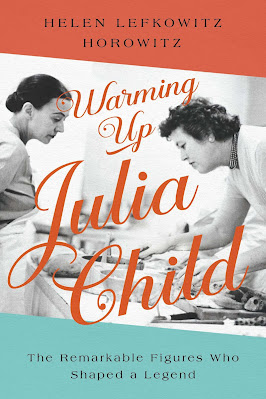Julia Child was the first person besides my Mom that I saw cook food. Of course, it was easier to watch my Mom, standing on a chair in our kitchen and being up close (and if I was lucky, getting to lick the beaters). Julia Child I first saw on PBS, on a Saturday. I didn't know what to think of this woman who gestured a lot, had an interesting voice, and seemed both incredibly gifted and a bit silly all at once. She made food I'd never heard of, and wasn't sure I'd like, either. My palate was definitely 1970's Midwest child.
It wasn't until I was much older, and my Mom had passed, that I found out she was not a born cook, and didn't really enjoy cooking much. But with eight children, she learned to cook. Julia, however, inspired me to be interested in cooking in a different way--to enjoy the process, to think about the ingredients, and most importantly, to inhale the results. She also taught me it's okay to fail sometimes, and that sometimes the end results don't look so great, but taste wonderful.
I never thought much about how Julia Child became the star that she was until I read Warming Up Julia Child. While it is true many famous people have that star quality, it's usually with the help of others that their potential develops and shines. That was also true for Julia.
This non-fiction book examines the six people who were part of Julia's life at a crucial time: the beginnings of her work on what would become Mastering the Art of French Cooking. While I knew this cookbook was years in the making, I had no idea just how many years Julia and her friend Simone Beck worked on it. The back and forth of letters, the visits--it's mind boggling to think they persisted in creating this cookbook. Author Helen Lefkowitz Horowitz brings their relationship to life using actual correspondence and diary entries of the two women, along with Julia's husband Paul. Simone and Paul weren't the only players in Julia's life: Avis DeVoto helped get their cookbook into the hands of Judith Jones and William Koshland at Knopf after Houghton Mifflin turned it down. Judith helped shape the final cookbook with Julia, and William's influence at Knopf proved invaluable. Finally, there was Ruth Lockwood at WGBH in Boston, where Julia became famous with her French Chef cooking show (the one I saw as a kid). The relationships between all the players are fascinating and you really get a good sense of all the work involved over the years in developing and maintaining those relationships through thick and thin.
Though photos, voluminous correspondence, and diary entries we get a peek inside Julia's mind, Paul's frustrations in a job that made him deeply unhappy, and the ups and downs of friendships. The process of creating a cookbook is beyond difficult, and I am amazed and impressed at Julia and Simone's determination to keep moving forward for ten years. Imagine that: working on a cookbook for ten years. And that cookbook has gone on to sell over 1.5 million copies (as of 2019) and is still in print and considered a classic.
I enjoyed this behind the scenes look at Julia's friendships and business partnerships with the people who helped her become the beloved chef we came to know. It is especially interesting to get a peek into her marriage to Paul, and just how much he supported her throughout their marriage. They truly were a perfect match.
If you are a fan of Julia Child, this should be on your TBR list. I think in today's world we often see the finished product and fail to think about the work that was required to bring that product to fruition. Julia was brilliant, and lucky to be surrounded by a group of people who believed in her, believed in her cookbook, and worked hard to see it published.
A big thank you to Pegasus Books for a chance to read and review this book. Publication date is April 5th (just a few days away!) and the book will be available in hardcover and ebook.



No comments :
Post a Comment